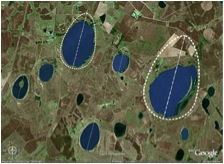While I was home in Greenville, South Carolina, for winter break, I read in the local paper that a huge percentage of the wetlands in my state are completely unprotected by environmental regulations. Through a combination of policy loopholes and local noncompliance, isolated wetlands—those not connected to a major waterway—can be destroyed by developers without permits or environmental assessments. This includes the South’s most mysterious soggy ecosystems: the Carolina Bays.
These strange formations, pictured here, are elliptical depressions with one end pointing northwest and the other pointing southeast, like scattered eggs all aiming in the same direction. Their eerie regularity inspires some interesting origin stories—local lore suggests that the Carolina Bays were formed by asteroid impacts or extraterrestrial visitors—but wind erosion is the more likely explanation.
Rich in both cultural and ecological significance, isolated wetlands were the subject of a recent S.C. Supreme Court ruling, which held that developers must obtain state permits to fill isolated wetlands like the Carolina Bays. However, some state legislators are determined to reverse the decision with specific legislation exempting isolated wetlands from permitting requirements. Considering recent national outcry against the EPA, coupled with South Carolina’s conservative leanings, such legislation is likely to pass. This is just one example of the progressive breakdown of wetlands regulation in the United States today.
Wetlands policy was one of the United States’ earliest experiments in market interventions for environmental protection, and though mitigation banking is generally regarded as an abject failure in terms of environmental protection, its meager economic success promises to carry it into the future.
The EPA defines a mitigation bank as “a wetland, stream, or other aquatic resources area that has been restored, established, enhanced, or preserved for the purpose of providing compensation for unavoidable impacts to aquatic resources …”. It adds a third party to the industry-government interface to take on the responsibility for the permit-holder’s destruction of wetlands by creating or restoring comparable wetlands elsewhere. Today, there are more than 450 mitigation banks nationwide, 60 of which have sold out of credits, and an additional 200 banks have been proposed. This high level of participation hides the fact that the mitigation banking system is plagued by serious problems of noncompliance and double- or even triple-counting of constructed wetlands as offsets for those that are destroyed. Furthermore, few of the constructed wetlands perform the same ecological, environmental, social, or cultural functions that they were intended to replace, and they are frequently allowed to fall into disrepair.
Present conditions are not promising for any sort of substantive wetlands policy reform, though it is sorely needed. The EPA is so maligned by the political right that it is hard to imagine any major reform gaining sufficient support to be enacted. These conditions make market measures more appealing, as they are popular among conservatives and therefore more likely to gain support, but past failures suggest that market measures create their own problems and, at least in the case of mitigation banking, conservation is not their true motive.
Therefore, the most politically feasible approach at present seems to be to work within existing policy frameworks to make enforcement more consistent and to better police mitigation banks. Doubling the size of mitigation banks relative to wetland development sites didn’t work, but maybe tripling it could. Harsher penalties for misconduct in wetland banking could deter firms from double-counting banks or allowing them to fall apart.
The first priority in terms of reform should be to exempt those ecosystems, like the Carolina Bays, that are the most complex and provide the greatest benefits in terms of environmental services. Few wetlands, it seems, can accurately be reproduced, but protecting those with the greatest ecological value would be a major step toward halting their decline. The EPA is also making efforts to incorporate the concept of sustainability into all of its practices, as signaled by a recent National Academies study on Sustainability and the EPA. This could a first step toward a more modern framing of environmental issues in an interdisciplinary context.
Established in 1995, the Georgetown Public Policy Review is the McCourt School of Public Policy’s nonpartisan, graduate student-run publication. Our mission is to provide an outlet for innovative new thinkers and established policymakers to offer perspectives on the politics and policies that shape our nation and our world.
